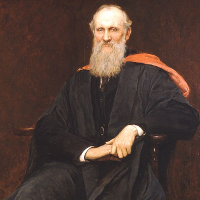Celebrating the life and work of Sir William Thomson Baron Kelvin of Largs
William Thomson, more commonly known as Lord Kelvin, was an exceptional scientist and successful businessman, whose solutions to theoretical problems in physics and ingenious inventions have transformed modern life.
Ties to the University of Glasgow
Kelvin had come to Glasgow at the age of ten in 1832, after his father was appointed Professor of Mathematics at the University. His ties to the University had always been reinforced through family connections; his brother, James, also became a Professor of Engineering in 1873. After retiring from teaching, Kelvin enrolled as a research student, with a desire to remain affiliated with the University.
Then finally, in 1904, Kelvin was elected Chancellor of the University of Glasgow. He held this position until 1907, remaining dedicated to his work up until 3 weeks before his death.
He was one of both the youngest and oldest matriculated student of the University, first registering as a student when he was only ten years old, and again when he retired at 75.
Accomplishments
Some of his more transformative and recognisable accomplishments include paving the way for the global communication highway with his work on planning the Trans-Atlantic telegraph cable, for which he was knighted in 1866 by Queen Victoria, becoming Sir William Thomson.
He is equally revered for other important inventions such as his sound machine and Kelvin compass, which greatly increased safety at sea and was adopted by navies around the world. Kelvin also made breakthroughs that laid the groundworks for the development of refrigerators – his work is still celebrated today by the US brand ‘Kelvinator’! His academic work was also highly valued, having published more than 600 scientific papers during his lifetime and proposing an absolute scale of temperature, now known as the Kelvin Scale.
Teaching career
Kelvin was a Professor of Natural Philosophy at the University for 53 years, from 1846 to 1899, teaching over 7,000 students from all over the world. He then went on to serve as Dean of Faculties from 1901 to 1903, and then as Chancellor from 1904 to 1907. He eventually established a “School of Electrical Engineering”, an advanced class in mathematical physics and a laboratory in which they could experiment. In the lab, the students worked on problems linked to Kelvin’s own scientific and engineering research in electricity.
Peerage
For his achievements in thermodynamics, Kelvin became the first scientist to be elevated to the peerage when he was ennobled in 1892, becoming Baron Kelvin of Largs. He died at his home in Ayrshire and was buried in Westminster Abbey on 23 December 1907.

Lord Kelvin
Mathematician and Physicist
Born: 26 June 1824, Belfast, Northern Ireland.
Died: 17 December 1907.
University Link: Alumnus, Chancellor, Dean of Faculties, Graduate, Professor
GU Degree: LLD, 1896

Map
- Number 11 Professor's Square; Kelvin's home from 1870. His clock remains in the entrance.
- The Hunterian Museum has a permanent exhibition on the work of Kelvin including many of his original papers, instruments, and other artifacts, such as his smoking pipe.
- The Senate Room; Once Kelvin's Natural Philosophy apparatus room and classroom.
- Sundial (at South Front), believed to have been made by Lord Kelvin.
- Kelvin statue in the Kelvingrove Park.
- Memorial Gate where Lord Kelvin's name is displayed along with other distinguished figures.

